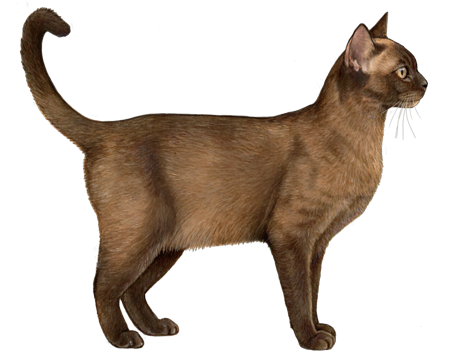
Japanese Bobtail
Friendly, intelligent cats, Japanese Bobtails are always up for an adventure. They're loyal to their people and get along well with other pets and kids. Plus, having a Japanese Bobtail in the family is considered good luck.
Interested in discovering if your cat is a Japanese Bobtail?
Check out Wisdom Panel's DNA test.
Japanese Bobtail Traits
General Appearance
Japanese Bobtails are medium-sized cats with a balanced, elegant appearance. They have unique eyes, high cheekbones, and long parallel noses.
Coat and Coloring
Japanese Bobtails come in both shorthaired and longhaired varieties. Shorthairs have medium-length, soft, silky hair with no undercoat. The longhairs medium-to-long coat is also soft and silky but with no noticeable undercoat. Their hair is longest on the tail and britches. And ear and toe tufts are common.
This breed comes in various colors—including solids, calico, vans, and bi-colors. Some have a tabby pattern that is either spotted, mackerel, or classic. Dramatic markings and contrasting colors are hallmarks of the Japanese Bobtail.
Distinctive Physical Traits
A unique pompom tail—courtesy of a dominant gene mutation—is the Japanese Bobtail's defining feature. No two tails are the same, but each is made of a combination of curves, angles, or kinks. The tail is clearly visible but doesn't extend more than three inches from the tailbone.
The Bobtail's other traits include a triangular head, upright ears, oval eyes, and slender but muscular legs.
Japanese Bobtail Temperament
Japanese Bobtails are outgoing, happy cats. They thrive on human companionship and want to be at the center of all family activities. Bobtails commonly follow their people around the house, conversing with them through melodious chirps and meows.
Bobtails are energetic and have natural athletic abilities that lend themselves to feline agility and obstacle courses. They have an endless desire to play and enjoy games of fetch and tag. Due to their inquisitive nature, they often take it upon themselves to investigate every nook and (high) cranny in the house.
Though they like to be near their humans and relax, Bobtails aren't typically lap cats. Sitting still for long periods is not their style—there's just too much to do and explore.
Japanese Bobtail History
The Japanese Bobtail appears in artwork and manuscripts dating back more than 1,000 years. As with many ancient breeds, the details of their early years are vague.
Some people believe Buddhist monks brought Japanese Bobtails to their temples to protect their rice paper scrolls from rats. Regardless, their keen hunting skills eventually led to a life on the streets. When rats threatened the silk industry in the 1600s, authorities deployed these proven hunters to the city streets to rid them of rodents.
The Japanese Bobtail is a symbol of luck in Japan and thought to bring prosperity to those who own one. Locals also use artwork portraying the breed to secure good fortune. The statue of a cat with one raised paw—commonly seen in shop doorways—is an artistic rendition of a Bobtail.
Elizabeth Freret brought the first Bobtails to the United States in 1968. Those three cats became the foundation stock for the American breeding program. Several years later, Freret made a case for breed recognition to the Cat Fanciers Association (CFA). In 1976, the CFA granted the Shorthair Japanese Bobtail Championship status. The Longhair Bobtail trailed behind, receiving Championship status in 1993.
Japanese Bobtail Care
Nutrition
Japanese Bobtails need a high-quality diet. Because nutritional needs vary for kittens, adults, and senior cats, opt for a formula that's age-appropriate for your pet.
To keep your cat at a healthy weight, measure out meals and reduce portions if necessary. And don't forget to account for calories from treats in their daily totals. As a guideline, treats should make up no more than 10% of a cat's calories.
Finally, all cats need access to fresh, clean water around the clock
Grooming
Japanese Bobtails need weekly brushing to remove dirt and loose hair. And during heavier shedding periods (in the spring and fall), they require more frequent brushing. When combing your cat's hair, it's also wise to check their ears for wax buildup or debris and clean them as needed.
Most cats' nails require monthly trimming to prevent them from getting too long. Long nails are more likely to snag on something and become torn or damaged. They can even grow into your cat's paw pads, leading to pain or infection. In addition to clipping, providing a scratching post will allow your cat to do some nail maintenance themselves (thanks to their instinct to scratch).
No grooming routine is complete without a little dental hygiene. To support your Japanese Bobtail's overall health, brush their teeth daily and schedule visits with your veterinarian for professional dental cleanings and exams.
Health
Roughly one out of every three cats in the United States is overweight or obese. And those extra pounds can contribute to other health risks—such as arthritis, diabetes, and heart problems. Your veterinarian is the best resource for tips on managing your cat's weight.
Breed Group
Asian
The Asian Group is comprised mainly of genetically similar breeds which vary widely in traits and personalities. These breeds are distinct from those of the Siamese and Oriental Group.
Resources
https://cfa.org/wp-content/uploads/2019/06/japanese-bobtail-standard.pdf
https://tica.org/breeds/browse-all-breeds?view=article&id=844:japanese-bobtail-breed&catid=79
https://cfa.org/japanese-bobtail/
https://www.hillspet.com/cat-care/cat-breeds/japanese-bobtail
https://tica.org/breeds/browse-all-breeds?view=article&id=1946
https://www.banfield.com/state-of-pet-health/obesity
Reviewed February 23, 2021 by Jamie Freyer, DVM













